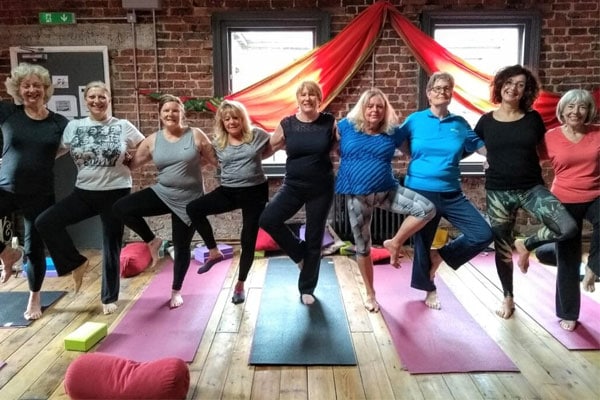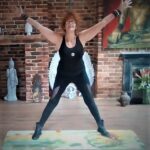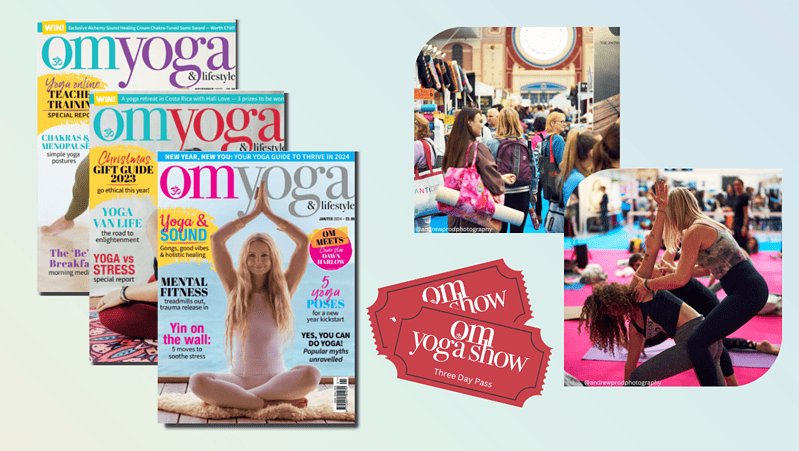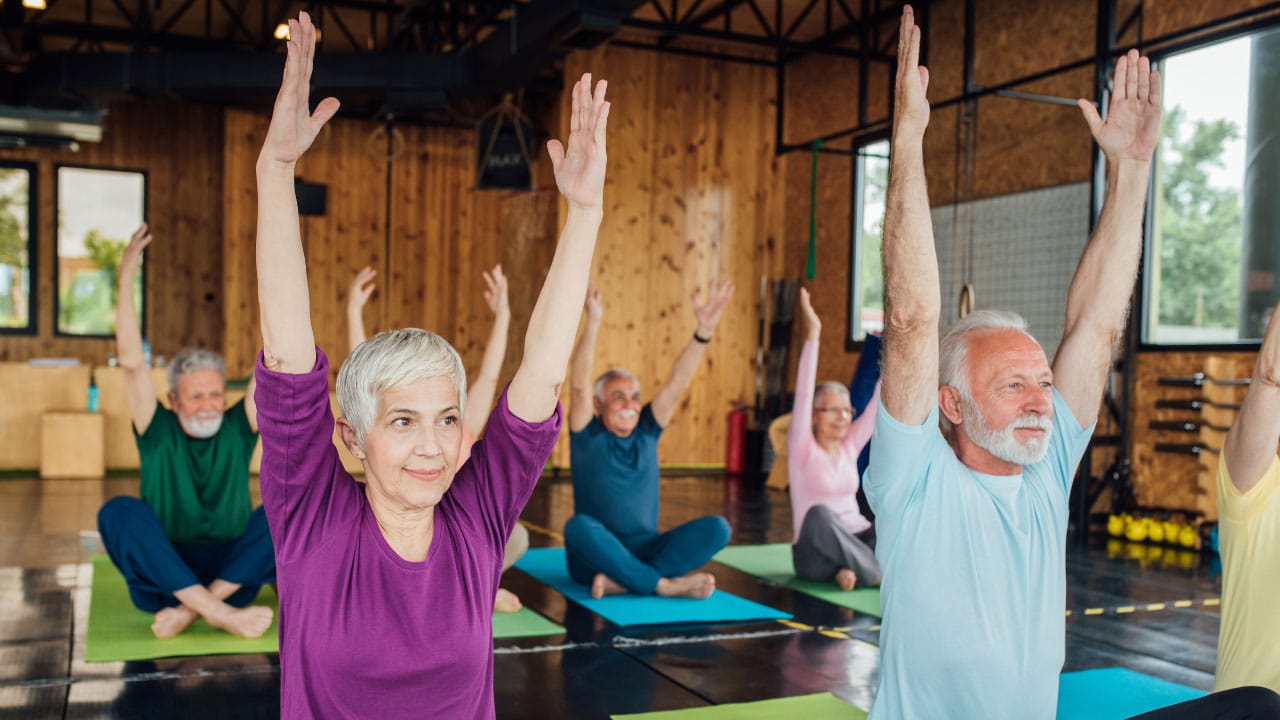
Yoga for ageing bodies
An elder teaching elders: adapting yoga and teaching for ageing bodies. By Sunny Peta
The biggest challenge of getting older, and at 70 I know it intimately, is that if we haven't had a regular yoga practice for many years, the body is no longer able to engage in what I call contorting yoga poses.
When I tell people I teach elders, I often hear: “Oh you do chair yoga?” No. My students are all fit enough to climb the stairs to the first floor Yoga Life Studio where I teach a 90-minute class on Monday mornings. But that doesn't mean they're in top shape. I love that I have some students who are still fairly fit, mingled in with those who are overweight, suffer from anxiety and are plagued with arthritis.
My 35-year love affair with yoga has been punctuated by some periods of yoga desert including five years in my forties where I ran three miles every morning and pulled weights in the gym and four years in my late fifties where I lived on the land in Georgia, USA. My yoga practice diminished because I was doing so much manual labour from digging gardens to hauling logs. When I got back to the UK in 2013, I turned to yoga to heal various traumas and help me deal with having to care for parents with cancer and dementia. I do not regret my decision to train as a yoga teacher at the ripe old age of 66.
Yoga for ageing bodies
The Sivenanda Vedanta urban ashram in London where I first started yoga required me to take a workshop that taught us the 12 poses including headstands and shoulder stands. I don't do those two poses anymore and I definitely don't teach them. I've done a lot of research into yoga and the ageing body and discovered that, unless we have a regular practice, these asanas can be dangerous. So I set about creating a yoga that would satisfy the needs of the older body without putting them at risk.
A survey of my students revealed that what they need most is mobility. Their overriding concern is that they will be stiffly shuffling around town on a zimmer frame or perched on a mobility scooter. Balance is also something that deteriorates as we age. My balance is off because I have a hip that juts out to the right and arthritic knees. I take great pleasure in telling my students that some of them have stronger balance-ability than I do. My body has forced me to become humble. Bernie Clark, author of Your Body, Your Yoga has informed me enough to share with my students facts such as how some people will never sit cross-legged with flat knees or be able to fold forwards like an ironing board because of the different skeletal structures.
The teacher training I took in Yoga Nidra and Yin Yoga taught me that a key factor in calming the mind is to bring attention into the body. I encourage my students to understand what is going on in their bodies and to feel into them as they practice. To do that, we need to go slowly. That's why I begin each class with a 10-minute supine relaxation. Anytime I've asked them “Do you want to start sitting?” they all shake their heads and lie down. My one male student asked me last week after a relaxation: “Can you do a class that's 90 minutes of this?”
Balance playtime
I've seen a lot of changes in the yoga world over the years and was heartened to notice that even some Ashtanga teachers are now modifying what they teach to go slower. I have never seen yoga as the only practice our bodies need so I cut out the cardio vigorous stuff and replaced it with a lot of slow movements including short flows and breathwork. My 25-year practice of chi kung has been invaluable and I sometimes incorporate a few movements as part of a warm up. There's a wonderful set of movements from Thomas Hanna's somatic practice that include spine and joint movements that are easy yet effective. We often begin with a few of these.
Balance can be challenging which is why I created a longer balance section and called it 'Balance Playtime'. I've developed what I call the balance practice before doing regular balances. I enjoy the laughter and smiles as we wave our hands in the air and practice almost falling down. Before Covid, we had so much fun doing partner balance in Warrior 3 and dancer and I always encourage them to use props and the wall, as I do, to help them get up into balance and at the end of my newsletter I often say “Remember to practice standing on one leg when you're brushing your teeth or washing the dishes.”
Flirt coach
I studied NLP and hypnosis for 7 years which led me to become Britain’s first ‘Flirt Coach’ with a career in coaching, facilitating workshops, writing and broadcasting. Those years of broadcasting on radio and TV taught me to modulate my voice. The voice is such a powerful tool and the right tone, rhythm and pace can generate instant relaxation. I like to say “I give great voice.”
I am also relentless in perfecting my auditory instructions because I've always found it difficult to be craning my neck in yoga trying to see the teacher. And I recognise that some people need the visual prompts. My understanding of how the mind works gives me concern when I hear teachers saying: “If you can't do that” or “Bend your knees if you need to” or “The full expression of the pose”.
Our brain, which has been conditioned for competition since we started kindergarten, sees that as a challenge or a feeling of 'less than' if they 'can't' and a feeling that they're not doing it properly if they aren't in the 'full expression'. It's a big challenge for all yoga teachers. Thank goodness many elders have gotten to a stage in life where they are done competing or excessively striving.
I like to encourage my students to feel a certain freedom in yoga. When we emerge from relaxation I tell them “You know how to stretch, you've been wiggling your fingers and toes, yawning and moving your body how it wants to be moved.” I send them video clips of movements they can do at home and offer a lot of variations and alternatives.
I'm not much into adjustments. My yoga teacher training, like most of them, spent a day on adjustments. I remember how one of my fellow students taking a practice class expressed how yummy it was because she would get to do adjustments and proceeded to adjust my fingers in Peaceful Warrior. The only adjustments I do are vocal, apart from a hands-on gentle pressure in Child’s pose and I always check if: (a) they want it and (b) if it's working for them. One lady always refrains because it puts pressure on her knees. I enjoy hearing their aaah's and mmmmm's.
Feel the move
One of my favourite yoga books is 'Exposing Yoga Myths'.
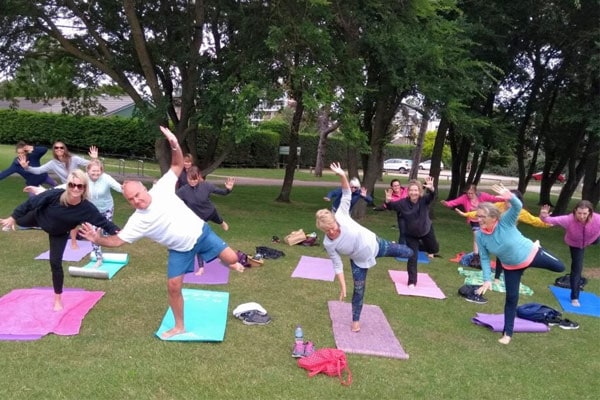
How delightful to realise that it's not necessary to achieve perfect symmetrical alignment and that for some with different body proportions the Vinyasa demand to switch from High lunge to Warrior 2 won't be so smooth… as it isn't for me. I got that it is okay to fiddle with my foot position in order to go from Dog to Plank. This stops the flow for me, but I am no longer afraid to do that.
I don't go in for much of the spiritual teachings of yoga because I know that my students are at an age where they're not seeking that as much as physical ease. They come to class to stretch, increase mobility, improve their balance, help ease aches and pains and relax. My teaching is designed to get them to feel every move, constantly reminding them to go slowly enough so that they can feel their edge and feel what's going on in their body step by step. 'Pain means No Gain'. One of the reasons I enjoy teaching a studio class versus one in the gym is because I get to know my students, their ailments and their needs.
I am also careful not to repeat yoga lore that suggests benefits that just don't exist, like twists massaging the organs, but I do explain how lying on their back with a block underneath their sacrum and legs up in the air will increase blood flow to the legs. In fact, this is the first part of a three-stage relaxation we do to music (no words), which is followed by a choice to do a Yin pose, Pontoon, where the much-stressed psoas muscles are relaxed before going into Savasana.I think all my students know where their psoas is and what it looks like. It's rewarding to see that, when given choices, they take them.
I am a freedom bunny and want my students to take charge of their own yoga and if that means doing something different or not doing something they will and not feel different or inadequate.
Teaching skills
I update my skills regularly by subscribing to the excellent Eckhart Yoga online service which for £120 a year is invaluable. I've incorporated many styles into my yoga class including my Yoga Nidra teacher, James Reeves's Tibetan Yoga, Christopher Gladstone's dragon yoga, and my all-time Yin mentor is Jose de Groot from whom I learned a variation of pigeon that is much easier than the regular one. I also bring in an element of Lauren Walker's Energy Medicine Yoga which has resulted in us doing a lymph tapping, flesh slapping, body waving, heel rebounding session when we come up to standing, after which we pause in Mountain with eyes closed to feel the tingles. I attend nine yoga and Pilates classes a week at the gym. It's great value and has its drawbacks in that it is set up for everyone to be able to attend any yoga class whereas in a small yoga studio I can specialise and give personal attention.
I tell my students that it is my utter joy to teach this Monday class, which now includes three former studio students who have settled happily into Zoom yoga. One likes to use as many props as possible, which was limited with Covid rules; another walks her new energetic dog and is too tired to walk to the studio and the lady who was my first student has heart issues and prefers not to be in a class whilst there is still some fear around Covid. And, although I can't see much of what they're doing, they've been practicing yoga with me long enough that it isn't an issue. And Zooming the studio class brings a little extra income.
Unfortunately, the two ladies in their mid 80’s who joined my class a few years ago, are no longer able to get to the studio but I was overjoyed when a virtually new-to-yoga student in her 70's said: “I don't think I'll be able to do a 90-minute class” and then got through it with ease and only one 'sit-out' to save her knees.
Marketing classes
When I first marketed this class I used a local network where a lot of older people 'hang out'. My audience don't really ‘do’ Facebook or Instagram even though I have a Facebook page. My ‘tribe’ isn’t looking to have the perfect body or hack a challenging pose and, if they were, I’d not be a great example.
I started by asking them if they were keen to do yoga but put off by the thought that they couldn't stand on their head or twist their bodies into pretzel poses and finished by telling them that, as an elder, I get them. I've got my own ailments inviting them to “bring your iffy hips and dodgy knees to class”.
Five people turned up. Not bad for one post in a small town. Now I regularly teach nine people every week. In a studio where I once packed in 17, Covid restrictions and the subsequent need to have more space, means I limit it to just 10 people. One lady who was a yoga therapist told me she really appreciates that I do this and we’re lucky to have through draughts via windows and a back door.
The only marketing I do now is to the converted, sending out a weekly email where I explain different poses and modifications. I make sure to explain how the body works, often including pictures of various muscle and skeletal structures. Ever since I started marketing my workshops as ‘Britain's first Flirt Coach’ in 1997, I've believed that people want information. When I publicise my classes occasionally I rarely include pictures of me doing poses. Instead, I use images of the happy band of elders [with their permission] because I think they want to know that they're coming to a class with people like them.
Unique approach
After breaking my fibula just before lockdown, I had to make a great effort to regain my yoga practice and I’m still not healed but without yoga and the pleasures of teaching the class, I cannot imagine how unpleasant life might have been. I am grateful that I got into yoga so long ago and that it is now part of my everyday life. I rarely watch regular TV but recently streaming a Channel 4 series I made a point of muting the adverts and doing yoga moves for the duration, a tip I pass on to my students along with “If you're sitting for any time, do a full body stretch every 15 minutes.”
My approach is not traditional but I sense it is perfect for the people I teach. My younger, 57-year-old friend, who is a ski, yoga and fitness fanatic keeps encouraging me to put on another class. I am not tempted. Age has taught me my limits and how to give my body what it needs without stressing that or my energy which has diminished with COPD. I have learned to give up striving and to do what works for my body and that doesn’t mean I don’t push right to my edge.
“Due to your uniqueness, what stops you might be totally different from what stops your yoga teacher, or, if you are a yoga teacher, what stops your students may be very different from what stops you.” - Bernie Clark, Your Body Your Yoga.
